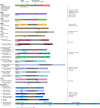A survey of Type III restriction-modification systems reveals numerous, novel epigenetic regulators controlling phase-variable regulons; phasevarions
- PMID: 29554328
- PMCID: PMC5909438
- DOI: 10.1093/nar/gky192
A survey of Type III restriction-modification systems reveals numerous, novel epigenetic regulators controlling phase-variable regulons; phasevarions
Abstract
Many bacteria utilize simple DNA sequence repeats as a mechanism to randomly switch genes on and off. This process is called phase variation. Several phase-variable N6-adenine DNA-methyltransferases from Type III restriction-modification systems have been reported in bacterial pathogens. Random switching of DNA methyltransferases changes the global DNA methylation pattern, leading to changes in gene expression. These epigenetic regulatory systems are called phasevarions - phase-variable regulons. The extent of these phase-variable genes in the bacterial kingdom is unknown. Here, we interrogated a database of restriction-modification systems, REBASE, by searching for all simple DNA sequence repeats in mod genes that encode Type III N6-adenine DNA-methyltransferases. We report that 17.4% of Type III mod genes (662/3805) contain simple sequence repeats. Of these, only one-fifth have been previously identified. The newly discovered examples are widely distributed and include many examples in opportunistic pathogens as well as in environmental species. In many cases, multiple phasevarions exist in one genome, with examples of up to 4 independent phasevarions in some species. We found several new types of phase-variable mod genes, including the first example of a phase-variable methyltransferase in pathogenic Escherichia coli. Phasevarions are a common epigenetic regulation contingency strategy used by both pathogenic and non-pathogenic bacteria.
Figures




Similar articles
-
DNA sequence repeats identify numerous Type I restriction-modification systems that are potential epigenetic regulators controlling phase-variable regulons; phasevarions.FASEB J. 2020 Jan;34(1):1038-1051. doi: 10.1096/fj.201901536RR. Epub 2019 Nov 28. FASEB J. 2020. PMID: 31914596 Free PMC article.
-
Phasevarions of bacterial pathogens - phase-variable epigenetic regulators evolving from restriction-modification systems.Microbiology (Reading). 2019 Sep;165(9):917-928. doi: 10.1099/mic.0.000805. Epub 2019 Apr 17. Microbiology (Reading). 2019. PMID: 30994440 Review.
-
Streptococcus suis Encodes Multiple Allelic Variants of a Phase-Variable Type III DNA Methyltransferase, ModS, That Control Distinct Phasevarions.mSphere. 2021 May 12;6(3):e00069-21. doi: 10.1128/mSphere.00069-21. mSphere. 2021. PMID: 33980672 Free PMC article.
-
Systematic Analysis of REBASE Identifies Numerous Type I Restriction-Modification Systems with Duplicated, Distinct hsdS Specificity Genes That Can Switch System Specificity by Recombination.mSystems. 2020 Jul 28;5(4):e00497-20. doi: 10.1128/mSystems.00497-20. mSystems. 2020. PMID: 32723795 Free PMC article.
-
Phasevarions of Bacterial Pathogens: Methylomics Sheds New Light on Old Enemies.Trends Microbiol. 2018 Aug;26(8):715-726. doi: 10.1016/j.tim.2018.01.008. Epub 2018 Feb 13. Trends Microbiol. 2018. PMID: 29452952 Free PMC article. Review.
Cited by
-
DNA sequence repeats identify numerous Type I restriction-modification systems that are potential epigenetic regulators controlling phase-variable regulons; phasevarions.FASEB J. 2020 Jan;34(1):1038-1051. doi: 10.1096/fj.201901536RR. Epub 2019 Nov 28. FASEB J. 2020. PMID: 31914596 Free PMC article.
-
Impacts of Mycoplasma agalactiae restriction-modification systems on pan-epigenome dynamics and genome plasticity.Microb Genom. 2022 May;8(5):mgen000829. doi: 10.1099/mgen.0.000829. Microb Genom. 2022. PMID: 35576144 Free PMC article.
-
No Change, No Life? What We Know about Phase Variation in Staphylococcus aureus.Microorganisms. 2021 Jan 25;9(2):244. doi: 10.3390/microorganisms9020244. Microorganisms. 2021. PMID: 33503998 Free PMC article. Review.
-
Moving toward the Inclusion of Epigenomics in Bacterial Genome Evolution: Perspectives and Challenges.Int J Mol Sci. 2024 Apr 17;25(8):4425. doi: 10.3390/ijms25084425. Int J Mol Sci. 2024. PMID: 38674013 Free PMC article. Review.
-
Neisseria meningitidis: using genomics to understand diversity, evolution and pathogenesis.Nat Rev Microbiol. 2020 Feb;18(2):84-96. doi: 10.1038/s41579-019-0282-6. Epub 2019 Nov 8. Nat Rev Microbiol. 2020. PMID: 31705134 Review.
References
-
- Moxon R., Bayliss C., Hood D.. Bacterial contingency loci: the role of simple sequence DNA repeats in bacterial adaptation. Ann. Rev. Genet. 2006; 40:307–333. - PubMed
-
- Atack J.M., Winter L.E., Jurcisek J.A., Bakaletz L.O., Barenkamp S.J., Jennings M.P.. Selection and counter-selection of Hia expression reveals a key role for phase-variable expression of this adhesin in infection caused by non-typeable Haemophilus influenzae. J. Infect. Dis. 2015; 212:645–653. - PMC - PubMed
Publication types
MeSH terms
Substances
LinkOut - more resources
Full Text Sources
Other Literature Sources
Molecular Biology Databases

